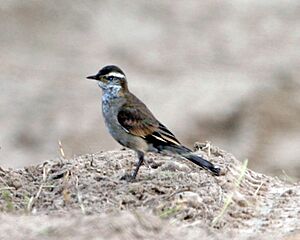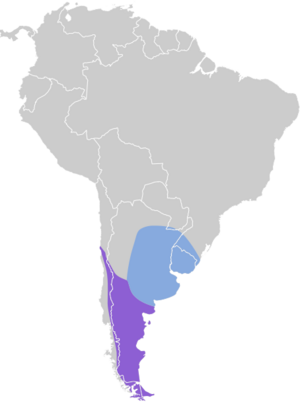Buff-winged cinclodes facts for kids
Quick facts for kids Buff-winged cinclodes |
|
|---|---|
 |
|
| Conservation status | |
| Scientific classification | |
| Genus: |
Cinclodes
|
| Species: |
fuscus
|
 |
|
| Synonyms | |
|
Cinclodes fuscus fuscus |
|
The buff-winged cinclodes (Cinclodes fuscus) is a cool type of bird. It belongs to the ovenbird family called Furnariidae. You can find this bird in several South American countries. These include Argentina, Brazil, Chile, Paraguay, and Uruguay. Sometimes, it even visits the Falkland Islands.
Contents
What's in a Name?
This bird used to have a different name: the bar-winged cinclodes. It also used to include other birds that looked similar. But scientists decided to split them into three different species around 2009. Now, we have the cream-winged cinclodes and the chestnut-winged cinclodes. To avoid confusion, our bird was renamed the buff-winged cinclodes. This helps everyone know exactly which bird we are talking about! This bird is also monotypic, meaning it's the only species in its group.
What Does the Buff-winged Cinclodes Look Like?
This small bird is about 15 to 19.4 centimeters (6 to 7.6 inches) long. It weighs around 29 to 33 grams (1 to 1.2 ounces). Both male and female birds look very similar.
- Head: They have a light, buff-white stripe above their eye. Their cheeks are bright white and flare out towards the back. The top of their head is dark gray-brown.
- Body: Their upper body is dark brown. Their wings are dark brown with wide, buff-colored edges. They have a narrow, reddish-brown band across their flight feathers.
- Tail: The middle tail feathers are dark brown. The outer feathers are blackish-brown with pale, reddish-brown tips.
- Underparts: Their chin is white, and their throat is white with thin dark lines. Their chest is a dull pale brown with faint streaks. Their belly is whitish-buff.
- Eyes and Beak: Their eyes are brown. Their beak is dark brown to blackish, sometimes with a lighter bottom part. Their legs and feet are dark.
Younger birds are usually more brightly colored than the adults.
Where Does the Buff-winged Cinclodes Live?
You can find the buff-winged cinclodes all year round in central and southern Chile. They also live in most of central and southern Argentina, including Tierra del Fuego. Some birds travel to northern Argentina, southern Brazil, southeastern Paraguay, and Uruguay. They have even been spotted on the Falkland Islands!
These birds like open, grassy areas. This includes places like páramo and puna (types of high-altitude grasslands). They also live in dry mountain scrublands, on Patagonian steppes (grassy plains), and even on beaches. You might also see them in open woodlands. They often stay near water, like bogs and streams. It's common to see them close to where people live too! They can live from sea level up to 3,000 meters (about 9,800 feet) high.
How Does the Buff-winged Cinclodes Behave?
Does the Buff-winged Cinclodes Migrate?
Yes, some buff-winged cinclodes are partly migratory. This means they travel to different places at certain times of the year. Many birds from Tierra del Fuego and Patagonia fly north after the breeding season. During the southern winter, they can be found in northern Argentina, southeastern Paraguay, and Uruguay. Some even go as far north as Rio Grande do Sul and Santa Catarina states in Brazil. Other birds might stay at the same latitude but move to lower, warmer places.
What Does the Buff-winged Cinclodes Eat?
The buff-winged cinclodes eats many different small creatures. These include insects and some snails. They also eat seeds. They usually look for food alone or in pairs. They hop and run on the ground, poking their beaks into wet or dry ground. They also search among rocks, beach debris, grass, and even in shallow water.
How Does the Buff-winged Cinclodes Raise Its Young?
Buff-winged cinclodes breed during the southern summer, from September to January or even later. They are monogamous, meaning a male and female bird stay together to raise their young. The male bird sings and flaps his wings to attract a mate.
They build their nests in burrows. These burrows are usually at the end of a tunnel they dig in an earth bank. They might also use cracks in rocks or holes in human-made walls. Sometimes, they even use old woodpecker holes! Both parents help build a soft nest inside the burrow using grass and hair. A female bird usually lays two to four eggs. We don't know exactly how long the eggs take to hatch or when the young birds leave the nest.
What Does the Buff-winged Cinclodes Sound Like?
The buff-winged cinclodes has a unique song! It's a short, fast, dry trill that sounds like "t-r-r-r-r-r-r-r-r-r-t." It lasts about 2 seconds and often starts with other call notes. They can sing from the ground, a rock, or even while flying. Their calls include a sharp "pfip" and a series of high-pitched tinkling notes. When flying, they make a sharp, whistled "tsip."
Is the Buff-winged Cinclodes in Danger?
The IUCN (International Union for Conservation of Nature) has listed the buff-winged cinclodes as a species of "Least Concern." This is good news! It means they are not currently in danger of disappearing. They live across a very large area. Even though we don't know their exact population size, it seems to be stable. There are no immediate threats to these birds. They are common in most places where they live. In some areas, they are even the most common type of cinclodes bird. Their homes are usually not disturbed much by human activities. In fact, they might even benefit from grazing animals in some areas.


